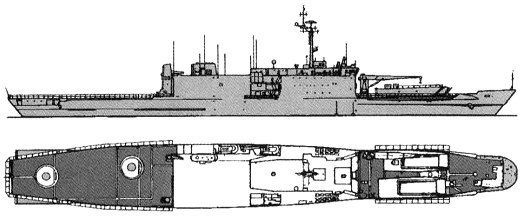
KANIMBLA auxiliary transports (1971/1994)

Kanimbla 2000
| Name | No | Yard No | Builder | Laid down | Launched | Comp | Fate |
| Kanimbla (ex-Saginaw) | L51 | National Steel SB, San Diego, USA | 24.12.1969 | 7.2.1970 | 23.1.1971 // 29.8.1994 | stricken 11.2011 | |
| Manoora (ex-Fairfax County) | L52 | National Steel SB, San Diego, USA | 28.3.1970 | 19.12.1970 | 16.10.1971 // 25.11.1994 | stricken 5.2011 |
|
Displacement standard, t |
4975 light |
|
Displacement full, t |
8450 |
|
Length, m |
159.2 |
|
Breadth, m |
21.2 |
|
Draught, m |
5.30 aft |
|
No of shafts |
2 |
|
Machinery |
6 Alco 16-251 diesels |
|
Power, h. p. |
16500 |
|
Max speed, kts |
22 |
|
Fuel, t |
diesel oil 1750 |
| Endurance, nm(kts) | 14250(14) |
|
Armament |
6 x 1 - 12.7/90, 4 helicopters (4 UH-60 Black Hawk or 3 Sea King) |
| Military load | 2 LCM(8), 2 LARC-5, 450 troops, 2000 t cargo |
|
Electronic equipment |
type 1007 radar |
|
Complement |
180 |
Project history: Decision to purchase made in 1993. Original official type designation was to have been THSS (Training and Helicopter Support Vessel), then LPH (Amphibious Warfare Helicopter Carrier), and auxiliary transports in 1998. Kanimbla was recommissioned on 29.8.1994. Manoora arrived Sydney 19.9.1994 with a mixed RAN and USN crew; formally commissioned 25-11-94. Conversion contract for both let to Forgacs Dockyard, Newcastle, New South Wales, in December 1995; work commenced on Manoora 23.5.1996 for completion in September 1997 and on Kanimbla 28.6.1996 for completion in Augut 1998, but various problems delayed completion until mid-2000 for Manoora and Febrary 2001 for Kanimbla.
Ships can transport 2000t of cargo on 1765m2 of deck space. Aft was a stern door for loading and unloading vehicles. The tank deck had a 75t-capacity turntable at both ends. Modifications included deletion of the bow ramp and beaching capability; installation of bilge keels; erection of a hangar capable of accommodating four Australian Army S-70 Blackhawk or three RAN Sea King helicopters between the funnels (which required deleting the starboard landing craft davit); installation of a 70t crane forward to handle two LCM(8) landing craft and two Army LARC-5 wheeled amphibious vehicles; and reconverting two (of three originally installed) vehicle fuel tanks to provide tankage for 250 tons of aviation fuel for the helicopters, for which there were three landing spots (one forward, for use after the landing craft have been offloaded). Provision to carry four pontoon causeway sections was deleted. A classroom/briefing room was added to both, and accommodations for troops were improved. The single Mk 15 CIWS systems aboard each ship were removed in Australia and added to the RANís pool of the weapons, but provision remained for their reinstallation. Installation of a Joint Task Force Headquarters (JTFHQ) on both was completed in 2001, respectively; occupying four compartments, the system provided the navyís most comprehensive afloat command, control, and communications facilities.
Modernizations: None.
Naval service: Both ships were stricke in 011 because of severe hull corrosion and many engines and systems problems.

Manoora 2008
© Ivan Gogin, 2017